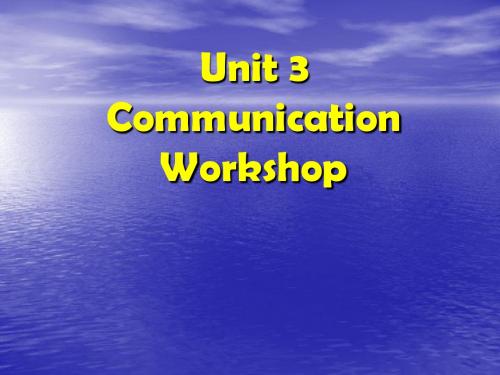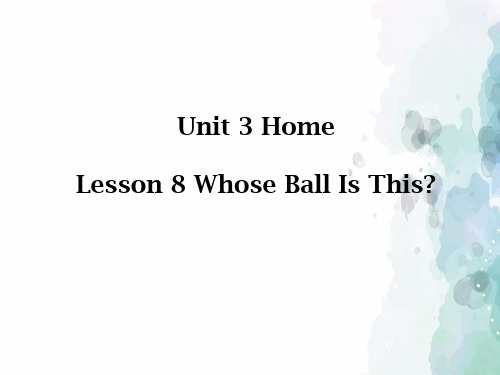北师大版七年级英语上册Unit3 Lesson8 第1课时 课件 (共14张PPT)
- 格式:ppt
- 大小:5.63 MB
- 文档页数:14





Unit 3 Lesson 8 Whose Ball Is This?(第一课时)Lesson Focus•Personal things, a / a pair of•Talking about who objects belong to•Possessive pronounsWarmupExercise 1Purpose: to help students know personal things➢Direct students to the photos. Ask " Do you know some of these items?"Have students say aloud the names of the items they know. If you feel your students are ready to do the exercise, you may skip this step.➢Read the Key Words aloud, having students repeat after you. You may also use the Picture Dictionary on page 106, Personal things, to teach the Key Words. Then say "Look at the Key Words and label the items".If students need support, have them work in pairs.➢Go over the answers, having individual students say the answers aloud.➢If you haven't done so yet, direct students to Personal things in the Picture Dictionary on page 106 for them to use as a reference. Answersa. towel;b. scissors;c. diary;d. crayon;e. key;f. toothbrush;g. trousers;h. glasses➢If time allows, do Workbook page 85, Exercise 1. Alternately, assignfor homework.ListeningExercise 2Purpose: to help students listen for specific information to match people with their things➢Direct students to the photo in Exercise 1. Say " This is Ben and his mum. Where do you think they are?" Elicit or provide They are at home.If you feel your students are ready to do the exercise, you may skip this step.➢Say "Ben and his mum are unpacking a box. Ben and his family have just moved to a new home. Listen to the dialogue. What things does his mum take out of the box?" Play the recording the first time. After students have listened, ask "What things does Ben's mum take out of the box?" Elicit or provide a ball, shoes, a diary, crayons, scissors, keys, glasses.➢Direct students to the list. Read the items aloud or have a student read them. Say " Listen and match the people with the things. Write B for Ben, L for Linda, M for Mum and D for Dad". Play the recording again.Monitor as your students match the people with the things. If students need support, you may have them work in pairs.➢Say "Now listen again and check". Play the recording a third time.Then go over the answers, having students say them aloud. Encouragethem to answer in plete sentences, for example, It's Ben's ball. Check students' pronunciation of the Key Words.Answers2. L;3. L;4. B;5. D;6. D;7. MExercise 3Purpose: to help students talk about who certain things belong to➢Ask a student "Can I borrow your pen?" Take the pen from the student and hold it up. Say in "Whose pen is this?" and write the question on the board. Elicit or provide It's (student's name ) 's pen. and write it on the board. Point to the answer and ask " Which word shows possession,or ownership?" Elicit or provide (student's name's. Point to the question and ask "Which word shows possession?" Elicit or provide Whose.Explain that when we want to know who owns something, we use the question word whose. If necessary, give a few more examples. a wails ➢Have two students read the Example dialogue. Then write on the board Whose shoes? Point out that shoes is plural and ask " How can we finish the question? Is it is this or are these?" Elicit or provide are these.Demonstrate with other nouns, forming questions, for example, Whose glasses are these? BUT Whose ball is this?➢Have students get into pairs. Then say "Now point to the items in Exercise 1. Take turns asking and answering questions about who owns each item". Monitor as students ask and answer questions, offering assistance as needed. Pay attention to students' use of possessive pronouns, apostrophes, whose and is this 1 are those. Check students' pronunciation of the Key Words.Expansion: Don't Stop!Note: Use this activity to give students more practice. Direct students to page 50. Have them ask and answer questions about who the things in Jenny's room belong to. They should produce questions and answers such as Whose caps are these? They're Jenny's. Whose model cars are these? They're Todd's. Whose umbrella is this? It's her mum's.Exercise 4Purpose: to help students know how to use a / an and a pair of➢Direct students to the Key Words in Exercise 1. Ask "Which nouns are singular and which are plural?" Elicit for singular crayon, diary, key, toothbrush and towel. Elicit for plural glasses, scissors and trousers.Write these sentences on the board: I have a towel. I have scissors. Ask " Why is there the article a in the first sentence but not in the second?"licit or provide Because towel is singular and scissors is plural. Explain that words like scissors, glasses and trousers are called pair nouns and are always plural. We don't use the articles a or an with pair nouns.Provide a few more example sentences to demonstrate: He has new glasses / brown trousers. He has an orange crayon / a small diary. If you feel students are ready to do the exercise, you may skip this step.➢Direct students to the chart. Read the two example items or have a student read them. Say "Write the Key Words from Exercise 1 in the Word Builder". Monitor as students write the words, offering assistance as needed. If students need support, you may have them work in pairs.➢Go over the answers, having individual students read them aloud. Answersa diary, a key, a toothbrush, a towel; a pair of scissors, a pair of trousers Expansion: Keep Building!Note: Use these activities with more proficient students.Activity 1: Ask students to brainstorm other pair nouns, for example, tights, stockings, jeans, slippers.Activity 2: Direct students to Exercise 2. Point out that crayons and keys are plural here, but can be singular, crayon, key. We don't usually use a pair of with singular nouns. Also, point out that a pair is singular; it is a or one pair, so we use a singular verb with this phrase, for example, This is a nice pair of shoes. Then have students take turns saying who the things belong to, encouraging them to use the phrase a pair of, for example, The pair of shoes is Ben's.。

北师大版英语七上Unit 3 Lesson 8 WhoseBall Is This 说课稿一. 教材分析北师大版英语七上Unit 3 Lesson 8 “Whose Ball Is This?” 是一篇关于日常用品归属的对话课。
通过本节课的学习,学生能够掌握日常生活中常见的物品词汇,如:ball, pen, ruler, etc.,并且能够运用疑问词“Whose” 询问物品的归属。
同时,学生还能够学会用“It’s…’s.” 结构来回答物品的归属问题。
本节课的内容与学生的生活紧密相连,有利于激发他们的学习兴趣。
二. 学情分析七年级的学生已经掌握了一定的英语基础知识,具备一定的听说读写能力。
他们在日常生活中也经常会遇到类似的问题,例如询问物品的归属。
因此,他们对本节课的内容有一定的生活经验和认知基础。
然而,部分学生可能在发音和听力方面还存在一定的困难,需要在教学中加以关注。
三. 说教学目标1.知识目标:学生能够掌握日常生活中常见的物品词汇,如:ball, pen,ruler, etc.,并且能够运用疑问词“Whose” 询问物品的归属。
学生还能够学会用“It’s…’s.” 结构来回答物品的归属问题。
2.能力目标:学生能够在日常生活中运用所学知识进行简单的交流,例如询问和回答物品的归属。
3.情感目标:通过本节课的学习,学生能够培养对英语学习的兴趣,增强自信心。
四. 说教学重难点1.重点:学生能够掌握日常生活中常见的物品词汇,如:ball, pen,ruler, etc.,并且能够运用疑问词“Whose” 询问物品的归属。
学生还能够学会用“It’s…’s.” 结构来回答物品的归属问题。
2.难点:学生能够在实际情景中灵活运用所学知识进行交流。
五. 说教学方法与手段1.教学方法:采用任务型教学法,通过设定情境,让学生在实际操作中学习并运用所学知识。
2.教学手段:利用多媒体课件、图片、实物等辅助教学,提高学生的学习兴趣和参与度。